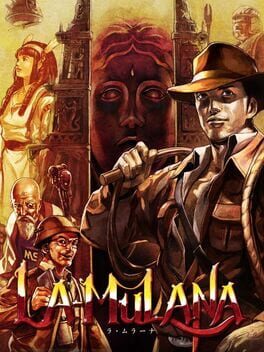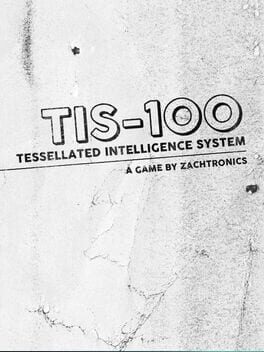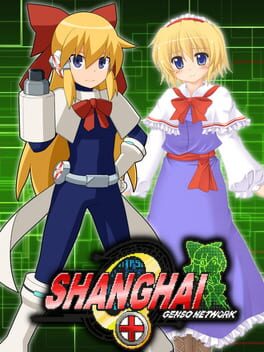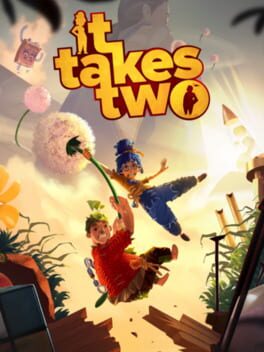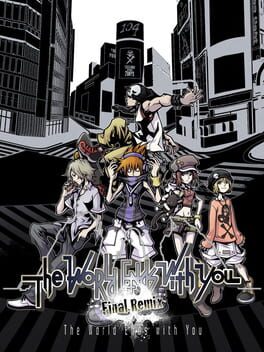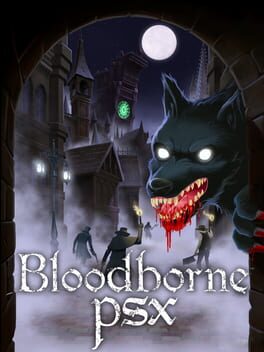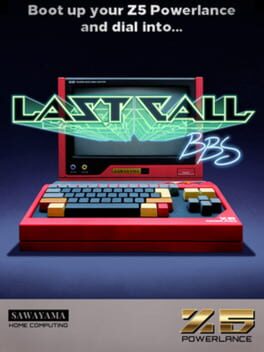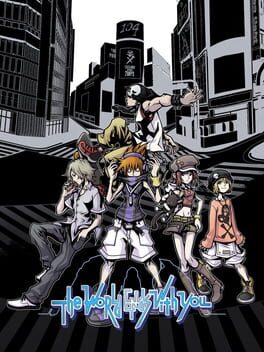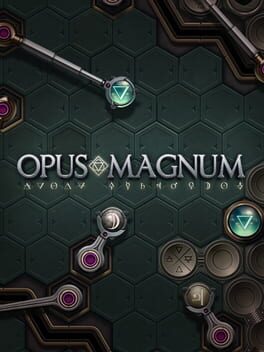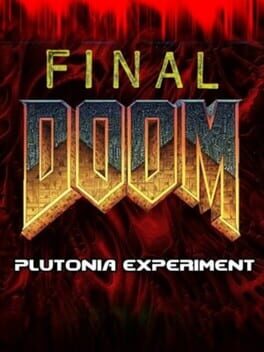Bio
I know not what this land offers.
I know not what this land offers.
Badges

Best Friends
Become mutual friends with at least 3 others

Listed
Created 10+ public lists

Donor
Liked 50+ reviews / lists

3 Years of Service
Being part of the Backloggd community for 3 years

GOTY '21
Participated in the 2021 Game of the Year Event

Trend Setter
Gained 50+ followers

Well Written
Gained 10+ likes on a single review

Liked
Gained 10+ total review likes

Elite Gamer
Played 500+ games

GOTY '20
Participated in the 2020 Game of the Year Event

Gamer
Played 250+ games

N00b
Played 100+ games

Popular
Gained 15+ followers

Noticed
Gained 3+ followers
Favorite Games
617
Total Games Played
002
Played in 2024
078
Games Backloggd
Recently Played See More
Recently Reviewed See More
As charming as a broad scope exploration of individuality via an exuberant shonen mission structure could be, especially on the Nintendo DS. The core message of the game is summarized wonderfully by the title The World Ends With You (henceforth shortened to TWEWY, for the sake of brevity). Individuals have their own inner worlds that are impossible to truly understand. But it is still worth expanding your world by reaching out to trust others, communicating with them, and experiencing new things.
This notion forms the crux for the main character, Neku’s arc. Initially, he’s a person who pursues self-isolation as a severe extrapolation of a principle peddled by his favorite graffiti artist. He’s dragged into the Reaper’s Game, a set of daily missions over a week that is almost hilarious in cruelty. It requires a partner and enables cooperation between teams, only to reward exactly one person at the end of it all. Over three weeks, Neku meets partners that guide him to a better place. Shiki, a deeply self-conscious individual who puts helping Neku over her own life. Joshua, a stubborn rascal with a smug misanthropic enabling tone who tries to pull Neku back after his initial growth. Beat, a self-sacrificial rebel who is dragged around by the powers that be after losing something fundamental to his life, providing a chance for Neku to help someone amidst abject isolation.
One of the most impactful questions for my understanding of the story comes at the very end. The final boss merely asks Neku if he likes people or not. One among numerous choices the game offers you where your decisions don’t really “matter” beyond flavor, but one where the answer reflects different tones of the thesis. Saying “Yes” implies growth for Neku and his newly attained appreciation of other people in his life, but saying “No” implies Neku understands the strengths of reaching out despite its very nature as a gamble. TWEWY’s perspective at the end is a positive answer with an asterisk. It emphasizes the difference between expanding your world to trust other people and simply liking people as a baseline.
The game's subplots also fit into this broad mold. Most explore the importance of communication over letting our preconceptions of others fester over time. However, one subplot during the second week stands out to me. A timid salesman, who you help in the first week, becomes a relentless businessman seeking to control large portions of the pin and ramen industry in Shibuya. He uses a famous blogger’s ability to sway the public’s opinion as part of a marketing campaign. You help another ramen seller discover how to survive the ever-shifting tastes of Shibuya and help the blogger rebel against the commodification of his recommendations. A surprisingly fun poke at the very nature of corporate desire to control everything in culture, balanced against the hope of reclaiming one’s identity and passions against these overwhelming forces. Even the agent learns his mistake and is guided towards a more humble life that satisfies him.
If anything, the source of the larger conflict in the story is the sandpapering tendencies of corporatization. The source of the Red Pins used to mind control Shibuya and crush all individuality arises from the marketing campaign of the agent. The very hierarchy of the Reaper’s Game mimics that of a large corporation. At the bottom, we have relatively charming and friendly Reapers doing their work guarding exits. They’ll still try to kill you when the time is right, mind you, but they’re nice to their friends and that’s what counts. But on the upper end, you have cruel and eccentric individuals who want to bend the entire city to their will for the sake of a promotion or playing god.
The setting itself, Shibuya, is elevated to a mythical warzone. An eternal clash of fashion and values, amidst various levels of artifice. Brands, music, and graffiti scream loudly as the various notions of individuality peddled melt into an indiscernible cacophony. This backdrop is further elevated by the brands themselves being modeled after the Chinese Zodiac, and how each region of the map follows one of these brands. This ideal backdrop, paying homage to the iconography of the real place, depicts the strengths and consequences of expanding one’s world.
These ideas further mesh with the combat mechanics of the game. Neku and his partner are on two screens, controlled with disparate input schemes. A point often missed in discussions is that the characters barely see each other during combat. A lot of their combat lines express the trust that they start putting in each other. When one partner hits low health, you hear them plead that Neku carries the team or heal them. This initiates a sharp learning demand as you try to split your attention between the two characters, which eventually culminates in a zen state where you expand your world and handle them in parallel.
Less overtly incorporated are the RPG elements. TWEWY's armor system consists of Threads, which are associated with 13 different brands. A cute aspect of this is that you can eventually make Neku and his partners wear all sorts of dresses but you need to cross a threshold based on the character’s Bravery, further emphasizing the effort required and the power attained with expressing yourself. The experience system manifests itself as Pin Points of three types. The first type is based on battles and asks you to engage with the combat as much as possible. The second type requires you to set up a shop to interact with other players or play the hype minigame, Tin Pin Slammer, with others. The final type asks you to shut down your DS and stop playing for a day or so, giving you the chance to enact the game's message in the real world. The game also limits how much food your characters can eat in a day, further reinforcing this subtle call to action. It has been well over a decade since TWEWY's release, so you can’t expect to find many other people with a DS nearby, and the time-based experience system is easily broken by just changing the date settings of your DS. Regardless, these minor details are all part of the portrait TWEWY paints. A truly commendable feat that elevates the game well beyond the sum of its parts.
While on the topic, let’s change gears to more technical specifics regarding the gameplay.
TWEWY features a fascinating usage of the split-screen functionality of the DS, where the stylus controls Neku’s movement and pin actions on the bottom screen, while the D-Pad or Face Buttons controls his partner on the top screen. This creates a delightful back-and-forth since enemies are copied on both screens and you can damage them simultaneously using Neku’s pins and his partner’s combo map. The partner’s combo map contains directional inputs that end on symbols as part of a matching game. The more you successfully match the more stars you receive, and after a certain number of stars you can pull off Fusion moves that result in a lot of damage and light healing. Tying all of this together is the Light Puck that multiplies the damage of a finisher for one character before traveling across the screens to the other. A subtle dynamic emerges, where you attempt to finish the pin ability or the combo map string as the puck travels across the screen to optimize DPS. This cacophony of mechanics emphasizes parallel processing, and just like the cacophony of Shibuya, it just works!
Well kinda? I did play on as hard a difficulty I could stomach, and it doesn’t quite perfectly click. Bear in mind it still works well enough to be one of the most engrossing combat systems I’ve played in months, and TWEWY is very recommendable on that front alone. But it’s not quite perfect.
First in line is the Pin system. Neku’s actions are linked to numerous pins that perform attacks or abilities using the stylus. There’s a lot of variety to be found here, with pins covering melee attacks, ranged options, and defensive tools. You can mix and match these pins in up to decks of 6, and adapt these to the encounters and bosses accordingly. The game also stars a pin evolution system based on the 3 aforementioned types of Pin Points, and you can master these pins for minor buffs. Exciting stuff!
However, the first issue here is how certain pins don’t seem to work consistently or have bizarre inputs to pull off. Most inputs are simple enough, like slashing, scratching, and tapping. But some pins require zanier inputs include drawing circles and even screaming into the microphone! The DS’ touch screen sensitivity isn’t particularly adequate for precise movements, rendering some of the unique pin abilities extremely clunky at best and unusable at worst. Another significant hindrance is how you also use the stylus to control Neku’s movement and dodging. As a result, you can’t use certain pins too close to his sprite. You can certainly learn to deal with these limitations over time as you position yourself better and choose simpler decks, but it does leave a slightly sour taste that a few of the more bewildering pin abilities don’t pan out as smoothly.
Next up are Neku’s Partners. Each of Neku’s three partners has a combo map that functions as a way to navigate a predefined directional attack string. These strings end on symbols as part of a unique matching game that rewards you with stars the better you match. The partners further have different defensive options and air-games, changing their overall strategies.
The first of the three partners is Shiki. Functioning as a tutorial character, her attack string is fast and ends in an uppercut with a ton of I-frames. Her air attacks function as a short burst of double damage, and her defensive options include a counter-hit and a block. Her matching game is the simplest, as it quite literally is guessing and matching symbols from a set defined by the difficulty level. The next partner is Joshua who doesn’t attack per se, but rather “targets” the enemy numerous times and drops an object at the end of his attack string. He eventually unlocks a levitation ability that attacks enemies from above with sky beams, and his defensive options include a side-step and a counter that reverses enemy positions. His matching game requires you to compare numbers and is a step up in terms of complexity. He is the easiest to farm stars with since he doesn’t kill enemies as easily and has a matching game that provides you with the solution at the start. Finally, we have Beat who is a glass cannon of sorts. Rapid attack strings both on the ground and in the air, and his defensive options are a counter that lets you continue his air string or a block. His matching game is the most complex and requires you to match pairs of card suits that give you stars in bulk if you are successful, resulting in massive swings of power.
These partners provide ample scope for mastery with their matching games and DPS/build optimization. However, it’s hard to ignore that even on the highest difficulty it’s quite easy to kill practically every enemy and boss with a lot of mashing in one direction. This is particularly noticeable with Shiki. Her combo map is incredibly short and it’s really easy to build up stars for her Fusion by mashing one direction. This ends up in higher DPS as you don’t have to process the matching game at all and only have to pay attention to enemy attacks every once in a while. Heck, the I-frame packed uppercut at the end of her string reduces the cognitive load as well! Joshua is a bit better about this since his attack string doesn’t damage enemies until the very end, demanding some amount of reaction. Beat is probably the most button-mashy partner, but Week 3 manages to somewhat alleviate this by packing the screen with enemies during regular encounters and making bosses much faster.
It eventually boils down to preference in the post-game. Shiki is the easiest to control, has high counter damage, and consistently builds up stars. Joshua is the most technical to control and build around, but the post-game’s superboss practically demands his levitation abilities. Beat has the best attack strings, the most content balanced around him, and fits in almost every build. I like Beat the most as he fits my playstyle, and Joshua as a close second since he’s a fun character to optimize around.
Poor Shiki. She was a real one...
A core element of combat that is not communicated is the notion of Efficiency, where each pin class and partner has an associated hidden multiplier to their attacks. This functions as an interesting attempt at balancing pins by generally giving the harder-to-execute or slower pins a leg up in terms of damage, and incentivizes using a blend of rapid pins with low efficiency for filler damage and heavy hitters for puck-passing. There are still a few pins that slip through the cracks, combining both high efficiency and fast usage/recharge time (and on the opposite end low efficiency and slow use-time), but this system mostly works well. Pins are further classified into Positive, Negative, and Neutral based on if they are Melee, Ranged, or “Weird” attacks. This doesn’t play a significant role in the combat until you reach the post-game, where some enemy variants have noticeable defenses against them. If I had to complain here, I would have wanted to know about these systems earlier and be tested on them more often.
Now onto the enemies and encounter design. TWEWY’s enemy roster (labelled Noises) consists of numerous noise classes with variations based on in-game progression. The roster generally covers a lot of ground and threatens Neku and his partner in unique ways. There’s some overlap in roles based on in-class variation, but here’s the way I broadly classify them.
Passive noises serve as a threat over time or have slow attacks that can heavily punish you. As a result, these noises require you to occasionally divert your attention from the more aggressive enemies and keep their numbers in check. Frog noises try to leap off the characters and occasionally summon bubbles to slow Neku down. Some of them spawn Tadpole noises, which heavily slow Neku’s movement and poison him. Jellyfish noises are incredibly passive but slowly split to form small armies that pass lightning around to damage the characters. They can also inflict the debilitating immobilization debuff on either partner, but these attacks occur rarely.
Light noises are a higher priority than passive noises, but they function more as aggressive fodder to keep your characters busy. Wolf noises are the standard fare. They run around and jump at Neku and his partner to damage them. Crab noises scuttle around the ground and attempt to catch you off guard with grabs and ranged attacks. One variant can also block damage outright! Penguins are the most interesting of this class of noises. They have a long duration slap attack and can slide at you from a noticeable distance. To top it off, stronger variants can command a powerful coordinated attack against Neku that can set you back severely.
Medium noises function as the most common high priority targets throughout the game. Bear noises initially appear as towering creatures with a powerful swipe attack and an attack buff. However, they slowly disappear over time to make way for more dangerous targets. Mink noises are a great all-rounder with a slow melee and ranged attack, but their highlight is the invincible whirlwind attack where they move around the screen trying to damage you. I’d have preferred more aggressive homing with this attack, but these noises are exciting regardless. Hedgehog noises fill the ranged role. They try to run away often, launch quills that land on the ground, and even try to pierce Neku with a wall of spikes in case he gets too close. Kangaroo noises are my favorite enemy class by far. They have high health, a powerful kick attack, and a deadly jump and homing land attack. This makes them the most engaging noises, even on a one-on-one basis, as you have to move around constantly to avoid getting hit.
Heavy noises appear more often in the final week, and function as mini-bosses with unique requirements to damage. Rhino noises have high defense on one side, requiring you to move around to hit them. They are fairly slow and easy to avoid, but their tankiness makes them important to keep at bay. Shark noises are quite exciting! They hide underground with only a small hurtbox on their fin above the surface, leaping occasionally to bite either character. They can also eat smaller noises to buff themselves (which does make the encounters featuring Sharks much easier). Trapping them in a damage stun loop before they can get away makes for some hectic situations.
Two other noise classes function more like pseudo-bosses more than anything – Mammoths and Drakes. Mammoth noises are incredibly tanky enemies that are impossible to stun or juggle. Getting caught in any of their attacks will result in a rapid game over (at low levels, they just one shot you). Drakes have numerous long-lasting high damage moves that demand rapid dodging from Neku or high air-time from his partner. They’re also impervious to stuns and juggles. These two noises rarely feature any support.
The last few classes of noises fill the most unique roles but are unfortunately much rarer than I’d like. Flying noises like Bats and Ravens are mostly boss fodder, but they still stand out since they demand certain ranged pins or require melee attacks with vertical hitboxes from Neku, and force his partner into a constant air attack state. Shrew noises constantly hide away in holes and pop out occasionally to surprise you with a bomb or a dive attack. Fox noises are really rare and work as weird shapeshifters that change between noise classes.
Halfway through the game, you meet the Taboo variants of the noise classes. These have more complex and deadly moves compared to any other variant (apart from optional boss variants). But the unique aspect of these noises is how you can only deal high damage to them with a partner only when they have the puck. Finally, you have Reapers, who don’t seem to do much of anything? Not sure what these guys are on. They can phase between screens, but only occasionally do a ranged attack. Somewhat annoying since they start to replace the much more interesting Taboo Noises in the final week.
Finally, I want to briefly mention the bosses of this game. They’re generally excellent! Especially in the latter half. Early bosses amount to slightly beefed-up versions of regular enemies or have tons of basic fodder elongating their fights, but once you hit the second week you start cooking with gas. Numerous aggressive bosses show up, forcing you to master the combat system or die. Some require you to survive for a fixed amount of time, and others feature almost laughably powerful fodder enemies. The final week is where all safeguards are removed. Brutal dual boss pairings, the hardest optional boss noises, and devastating debuffs galore. Fun for the whole family!
Another commendable aspect of TWEWY is how the difficulty and leveling systems are implemented. You can customize how you want to control your partner, change your difficulty level at any time, and you can reduce your in-game level for a higher pin drop rate. The reduction system allows you to chain numerous encounters together and makes them harder as you progress. An excellent step for accessibility, while letting players challenge themselves as much (or as little) as possible without compromising the message of the game.
However, despite a great admiration for what TWEWY accomplishes, there are some story additions to the game via Final Remix that sour me on the direction the series could be taking, especially since those are rendered canonical via the existence of NEO. Somewhat surprising that I ended up here since the NEO demo was what convinced me to play TWEWY in the first place! I was rewarded with this gem of a game, but now I somewhat question the integrity of the sequel. For a game that extols the bittersweet threads of individuality and stands as a unique cultural capsule of mid-2000s Shibuya, it’s surprising to see the sequel's demo so strongly flaunt its return like a phoenix only to end up in TWEWY’s shadow. I certainly hope NEO doesn’t end up as a milquetoast celebration of the strengths of the original.
There could very well be an interesting story to tell here. Shibuya’s culture has aged by more than a decade, and the bombastic war between multiple brands and countercultures has shifted heavily in favor of homogenized corporatization. The demo hinted at a pushback against this new culture, so it can’t hurt to keep an open mind I guess? Especially since Neo comes out like tomorrow. Might even try playing TWEWY Final Remix afterwards, even if the basic implementation of the combat engine is a far cry from the more thematically coherent vision of the original. However, I have heard interesting things about the co-op as an alternative approach, and the gameplay additions are alluring.
But gosh darn it, trepidations about the future of this series are best left for another time. I will heartily recommend this game to anyone. A delightfully unique combat system that pushes the limits of its console. An endearing story with one of the coolest sounding titles ever. All wrapped up in one of the most stylized and thematically cohesive shells I’ve seen in gaming.
Get a DS for this one.
This notion forms the crux for the main character, Neku’s arc. Initially, he’s a person who pursues self-isolation as a severe extrapolation of a principle peddled by his favorite graffiti artist. He’s dragged into the Reaper’s Game, a set of daily missions over a week that is almost hilarious in cruelty. It requires a partner and enables cooperation between teams, only to reward exactly one person at the end of it all. Over three weeks, Neku meets partners that guide him to a better place. Shiki, a deeply self-conscious individual who puts helping Neku over her own life. Joshua, a stubborn rascal with a smug misanthropic enabling tone who tries to pull Neku back after his initial growth. Beat, a self-sacrificial rebel who is dragged around by the powers that be after losing something fundamental to his life, providing a chance for Neku to help someone amidst abject isolation.
One of the most impactful questions for my understanding of the story comes at the very end. The final boss merely asks Neku if he likes people or not. One among numerous choices the game offers you where your decisions don’t really “matter” beyond flavor, but one where the answer reflects different tones of the thesis. Saying “Yes” implies growth for Neku and his newly attained appreciation of other people in his life, but saying “No” implies Neku understands the strengths of reaching out despite its very nature as a gamble. TWEWY’s perspective at the end is a positive answer with an asterisk. It emphasizes the difference between expanding your world to trust other people and simply liking people as a baseline.
The game's subplots also fit into this broad mold. Most explore the importance of communication over letting our preconceptions of others fester over time. However, one subplot during the second week stands out to me. A timid salesman, who you help in the first week, becomes a relentless businessman seeking to control large portions of the pin and ramen industry in Shibuya. He uses a famous blogger’s ability to sway the public’s opinion as part of a marketing campaign. You help another ramen seller discover how to survive the ever-shifting tastes of Shibuya and help the blogger rebel against the commodification of his recommendations. A surprisingly fun poke at the very nature of corporate desire to control everything in culture, balanced against the hope of reclaiming one’s identity and passions against these overwhelming forces. Even the agent learns his mistake and is guided towards a more humble life that satisfies him.
If anything, the source of the larger conflict in the story is the sandpapering tendencies of corporatization. The source of the Red Pins used to mind control Shibuya and crush all individuality arises from the marketing campaign of the agent. The very hierarchy of the Reaper’s Game mimics that of a large corporation. At the bottom, we have relatively charming and friendly Reapers doing their work guarding exits. They’ll still try to kill you when the time is right, mind you, but they’re nice to their friends and that’s what counts. But on the upper end, you have cruel and eccentric individuals who want to bend the entire city to their will for the sake of a promotion or playing god.
The setting itself, Shibuya, is elevated to a mythical warzone. An eternal clash of fashion and values, amidst various levels of artifice. Brands, music, and graffiti scream loudly as the various notions of individuality peddled melt into an indiscernible cacophony. This backdrop is further elevated by the brands themselves being modeled after the Chinese Zodiac, and how each region of the map follows one of these brands. This ideal backdrop, paying homage to the iconography of the real place, depicts the strengths and consequences of expanding one’s world.
These ideas further mesh with the combat mechanics of the game. Neku and his partner are on two screens, controlled with disparate input schemes. A point often missed in discussions is that the characters barely see each other during combat. A lot of their combat lines express the trust that they start putting in each other. When one partner hits low health, you hear them plead that Neku carries the team or heal them. This initiates a sharp learning demand as you try to split your attention between the two characters, which eventually culminates in a zen state where you expand your world and handle them in parallel.
Less overtly incorporated are the RPG elements. TWEWY's armor system consists of Threads, which are associated with 13 different brands. A cute aspect of this is that you can eventually make Neku and his partners wear all sorts of dresses but you need to cross a threshold based on the character’s Bravery, further emphasizing the effort required and the power attained with expressing yourself. The experience system manifests itself as Pin Points of three types. The first type is based on battles and asks you to engage with the combat as much as possible. The second type requires you to set up a shop to interact with other players or play the hype minigame, Tin Pin Slammer, with others. The final type asks you to shut down your DS and stop playing for a day or so, giving you the chance to enact the game's message in the real world. The game also limits how much food your characters can eat in a day, further reinforcing this subtle call to action. It has been well over a decade since TWEWY's release, so you can’t expect to find many other people with a DS nearby, and the time-based experience system is easily broken by just changing the date settings of your DS. Regardless, these minor details are all part of the portrait TWEWY paints. A truly commendable feat that elevates the game well beyond the sum of its parts.
While on the topic, let’s change gears to more technical specifics regarding the gameplay.
TWEWY features a fascinating usage of the split-screen functionality of the DS, where the stylus controls Neku’s movement and pin actions on the bottom screen, while the D-Pad or Face Buttons controls his partner on the top screen. This creates a delightful back-and-forth since enemies are copied on both screens and you can damage them simultaneously using Neku’s pins and his partner’s combo map. The partner’s combo map contains directional inputs that end on symbols as part of a matching game. The more you successfully match the more stars you receive, and after a certain number of stars you can pull off Fusion moves that result in a lot of damage and light healing. Tying all of this together is the Light Puck that multiplies the damage of a finisher for one character before traveling across the screens to the other. A subtle dynamic emerges, where you attempt to finish the pin ability or the combo map string as the puck travels across the screen to optimize DPS. This cacophony of mechanics emphasizes parallel processing, and just like the cacophony of Shibuya, it just works!
Well kinda? I did play on as hard a difficulty I could stomach, and it doesn’t quite perfectly click. Bear in mind it still works well enough to be one of the most engrossing combat systems I’ve played in months, and TWEWY is very recommendable on that front alone. But it’s not quite perfect.
First in line is the Pin system. Neku’s actions are linked to numerous pins that perform attacks or abilities using the stylus. There’s a lot of variety to be found here, with pins covering melee attacks, ranged options, and defensive tools. You can mix and match these pins in up to decks of 6, and adapt these to the encounters and bosses accordingly. The game also stars a pin evolution system based on the 3 aforementioned types of Pin Points, and you can master these pins for minor buffs. Exciting stuff!
However, the first issue here is how certain pins don’t seem to work consistently or have bizarre inputs to pull off. Most inputs are simple enough, like slashing, scratching, and tapping. But some pins require zanier inputs include drawing circles and even screaming into the microphone! The DS’ touch screen sensitivity isn’t particularly adequate for precise movements, rendering some of the unique pin abilities extremely clunky at best and unusable at worst. Another significant hindrance is how you also use the stylus to control Neku’s movement and dodging. As a result, you can’t use certain pins too close to his sprite. You can certainly learn to deal with these limitations over time as you position yourself better and choose simpler decks, but it does leave a slightly sour taste that a few of the more bewildering pin abilities don’t pan out as smoothly.
Next up are Neku’s Partners. Each of Neku’s three partners has a combo map that functions as a way to navigate a predefined directional attack string. These strings end on symbols as part of a unique matching game that rewards you with stars the better you match. The partners further have different defensive options and air-games, changing their overall strategies.
The first of the three partners is Shiki. Functioning as a tutorial character, her attack string is fast and ends in an uppercut with a ton of I-frames. Her air attacks function as a short burst of double damage, and her defensive options include a counter-hit and a block. Her matching game is the simplest, as it quite literally is guessing and matching symbols from a set defined by the difficulty level. The next partner is Joshua who doesn’t attack per se, but rather “targets” the enemy numerous times and drops an object at the end of his attack string. He eventually unlocks a levitation ability that attacks enemies from above with sky beams, and his defensive options include a side-step and a counter that reverses enemy positions. His matching game requires you to compare numbers and is a step up in terms of complexity. He is the easiest to farm stars with since he doesn’t kill enemies as easily and has a matching game that provides you with the solution at the start. Finally, we have Beat who is a glass cannon of sorts. Rapid attack strings both on the ground and in the air, and his defensive options are a counter that lets you continue his air string or a block. His matching game is the most complex and requires you to match pairs of card suits that give you stars in bulk if you are successful, resulting in massive swings of power.
These partners provide ample scope for mastery with their matching games and DPS/build optimization. However, it’s hard to ignore that even on the highest difficulty it’s quite easy to kill practically every enemy and boss with a lot of mashing in one direction. This is particularly noticeable with Shiki. Her combo map is incredibly short and it’s really easy to build up stars for her Fusion by mashing one direction. This ends up in higher DPS as you don’t have to process the matching game at all and only have to pay attention to enemy attacks every once in a while. Heck, the I-frame packed uppercut at the end of her string reduces the cognitive load as well! Joshua is a bit better about this since his attack string doesn’t damage enemies until the very end, demanding some amount of reaction. Beat is probably the most button-mashy partner, but Week 3 manages to somewhat alleviate this by packing the screen with enemies during regular encounters and making bosses much faster.
It eventually boils down to preference in the post-game. Shiki is the easiest to control, has high counter damage, and consistently builds up stars. Joshua is the most technical to control and build around, but the post-game’s superboss practically demands his levitation abilities. Beat has the best attack strings, the most content balanced around him, and fits in almost every build. I like Beat the most as he fits my playstyle, and Joshua as a close second since he’s a fun character to optimize around.
Poor Shiki. She was a real one...
A core element of combat that is not communicated is the notion of Efficiency, where each pin class and partner has an associated hidden multiplier to their attacks. This functions as an interesting attempt at balancing pins by generally giving the harder-to-execute or slower pins a leg up in terms of damage, and incentivizes using a blend of rapid pins with low efficiency for filler damage and heavy hitters for puck-passing. There are still a few pins that slip through the cracks, combining both high efficiency and fast usage/recharge time (and on the opposite end low efficiency and slow use-time), but this system mostly works well. Pins are further classified into Positive, Negative, and Neutral based on if they are Melee, Ranged, or “Weird” attacks. This doesn’t play a significant role in the combat until you reach the post-game, where some enemy variants have noticeable defenses against them. If I had to complain here, I would have wanted to know about these systems earlier and be tested on them more often.
Now onto the enemies and encounter design. TWEWY’s enemy roster (labelled Noises) consists of numerous noise classes with variations based on in-game progression. The roster generally covers a lot of ground and threatens Neku and his partner in unique ways. There’s some overlap in roles based on in-class variation, but here’s the way I broadly classify them.
Passive noises serve as a threat over time or have slow attacks that can heavily punish you. As a result, these noises require you to occasionally divert your attention from the more aggressive enemies and keep their numbers in check. Frog noises try to leap off the characters and occasionally summon bubbles to slow Neku down. Some of them spawn Tadpole noises, which heavily slow Neku’s movement and poison him. Jellyfish noises are incredibly passive but slowly split to form small armies that pass lightning around to damage the characters. They can also inflict the debilitating immobilization debuff on either partner, but these attacks occur rarely.
Light noises are a higher priority than passive noises, but they function more as aggressive fodder to keep your characters busy. Wolf noises are the standard fare. They run around and jump at Neku and his partner to damage them. Crab noises scuttle around the ground and attempt to catch you off guard with grabs and ranged attacks. One variant can also block damage outright! Penguins are the most interesting of this class of noises. They have a long duration slap attack and can slide at you from a noticeable distance. To top it off, stronger variants can command a powerful coordinated attack against Neku that can set you back severely.
Medium noises function as the most common high priority targets throughout the game. Bear noises initially appear as towering creatures with a powerful swipe attack and an attack buff. However, they slowly disappear over time to make way for more dangerous targets. Mink noises are a great all-rounder with a slow melee and ranged attack, but their highlight is the invincible whirlwind attack where they move around the screen trying to damage you. I’d have preferred more aggressive homing with this attack, but these noises are exciting regardless. Hedgehog noises fill the ranged role. They try to run away often, launch quills that land on the ground, and even try to pierce Neku with a wall of spikes in case he gets too close. Kangaroo noises are my favorite enemy class by far. They have high health, a powerful kick attack, and a deadly jump and homing land attack. This makes them the most engaging noises, even on a one-on-one basis, as you have to move around constantly to avoid getting hit.
Heavy noises appear more often in the final week, and function as mini-bosses with unique requirements to damage. Rhino noises have high defense on one side, requiring you to move around to hit them. They are fairly slow and easy to avoid, but their tankiness makes them important to keep at bay. Shark noises are quite exciting! They hide underground with only a small hurtbox on their fin above the surface, leaping occasionally to bite either character. They can also eat smaller noises to buff themselves (which does make the encounters featuring Sharks much easier). Trapping them in a damage stun loop before they can get away makes for some hectic situations.
Two other noise classes function more like pseudo-bosses more than anything – Mammoths and Drakes. Mammoth noises are incredibly tanky enemies that are impossible to stun or juggle. Getting caught in any of their attacks will result in a rapid game over (at low levels, they just one shot you). Drakes have numerous long-lasting high damage moves that demand rapid dodging from Neku or high air-time from his partner. They’re also impervious to stuns and juggles. These two noises rarely feature any support.
The last few classes of noises fill the most unique roles but are unfortunately much rarer than I’d like. Flying noises like Bats and Ravens are mostly boss fodder, but they still stand out since they demand certain ranged pins or require melee attacks with vertical hitboxes from Neku, and force his partner into a constant air attack state. Shrew noises constantly hide away in holes and pop out occasionally to surprise you with a bomb or a dive attack. Fox noises are really rare and work as weird shapeshifters that change between noise classes.
Halfway through the game, you meet the Taboo variants of the noise classes. These have more complex and deadly moves compared to any other variant (apart from optional boss variants). But the unique aspect of these noises is how you can only deal high damage to them with a partner only when they have the puck. Finally, you have Reapers, who don’t seem to do much of anything? Not sure what these guys are on. They can phase between screens, but only occasionally do a ranged attack. Somewhat annoying since they start to replace the much more interesting Taboo Noises in the final week.
Finally, I want to briefly mention the bosses of this game. They’re generally excellent! Especially in the latter half. Early bosses amount to slightly beefed-up versions of regular enemies or have tons of basic fodder elongating their fights, but once you hit the second week you start cooking with gas. Numerous aggressive bosses show up, forcing you to master the combat system or die. Some require you to survive for a fixed amount of time, and others feature almost laughably powerful fodder enemies. The final week is where all safeguards are removed. Brutal dual boss pairings, the hardest optional boss noises, and devastating debuffs galore. Fun for the whole family!
Another commendable aspect of TWEWY is how the difficulty and leveling systems are implemented. You can customize how you want to control your partner, change your difficulty level at any time, and you can reduce your in-game level for a higher pin drop rate. The reduction system allows you to chain numerous encounters together and makes them harder as you progress. An excellent step for accessibility, while letting players challenge themselves as much (or as little) as possible without compromising the message of the game.
However, despite a great admiration for what TWEWY accomplishes, there are some story additions to the game via Final Remix that sour me on the direction the series could be taking, especially since those are rendered canonical via the existence of NEO. Somewhat surprising that I ended up here since the NEO demo was what convinced me to play TWEWY in the first place! I was rewarded with this gem of a game, but now I somewhat question the integrity of the sequel. For a game that extols the bittersweet threads of individuality and stands as a unique cultural capsule of mid-2000s Shibuya, it’s surprising to see the sequel's demo so strongly flaunt its return like a phoenix only to end up in TWEWY’s shadow. I certainly hope NEO doesn’t end up as a milquetoast celebration of the strengths of the original.
There could very well be an interesting story to tell here. Shibuya’s culture has aged by more than a decade, and the bombastic war between multiple brands and countercultures has shifted heavily in favor of homogenized corporatization. The demo hinted at a pushback against this new culture, so it can’t hurt to keep an open mind I guess? Especially since Neo comes out like tomorrow. Might even try playing TWEWY Final Remix afterwards, even if the basic implementation of the combat engine is a far cry from the more thematically coherent vision of the original. However, I have heard interesting things about the co-op as an alternative approach, and the gameplay additions are alluring.
But gosh darn it, trepidations about the future of this series are best left for another time. I will heartily recommend this game to anyone. A delightfully unique combat system that pushes the limits of its console. An endearing story with one of the coolest sounding titles ever. All wrapped up in one of the most stylized and thematically cohesive shells I’ve seen in gaming.
Get a DS for this one.
Opus Magnum represents an interesting maturation in the Zachtronics catalogue. The most visually evident aspect of this maturation is that of aesthetic. Gone is the cold pragmatism of most former (and future) Zachlikes, and in its place is an inviting opulence. The green honeycomb background, the shiny metallic parts, and the revitalized alchemical imagery bring forth an evocative veneer that almost succeeds in hiding the fact that you are actually coding in disguise. The GIF maker is an ingenious rework from Infinifactory, resulting in easily sharable clips of people proud of their creations. And it’s hard not to be slightly proud of your contraptions, as they chug and rotate around following a mesmerizing periodic pattern.
This shift to a strongly appealing aesthetic fits inside a bigger push towards more accessibility. Zachtronics’ veterans will almost immediately note the sharp decline in the actual puzzle-solving challenge here. Compared to the multistaged grandeur of late-game Infinifactory or the spartan ruthlessness of TIS-100, Opus Magnum is fairly easy throughout its runtime. Part of this is a direct consequence of flirting with the infinite (or more like machine precision, which is practically infinite). The player has an astonishing amount of solving power at their disposal, unhindered by any form of space or instruction constraints. It becomes more a matter of when, rather than if, one can solve a puzzle. I was certainly disappointed by this realization. One of the core appeals of these games for me is being thrown into the wilderness and being asked to come out alive with the tools provided. This disappointment has subsided over the years for two reasons. The first is acknowledging the benefits of such openness with puzzle design and tool power. Seeing folks who have never played a Zachtronics game before brimming with satisfaction at their solution. Seeing them sharing their design in a beautiful and convenient manner. All this pokes directly at the heart of what makes the act of problem-solving so damn fun! There are four other games before this where I can baptize myself with fire if I so desire…
Regardless, the second reason is a bit more selfish. One that is another consequence of infinite solving power - incredible optimization depth. Now, here’s a confession. I have over 500 hours in this game. I will spend a thousand more over the coming years. I have performed relatively well in high-level tournaments and have a couple of optimization world records. Still, I would only consider myself somewhat competent at this game. So as a warning, this part is gonna get a bit technical and poke at some of the deeper design decisions and dilemmas that one faces as one falls down this rabbit hole.
Much like other Zachtronics games, the gameplay loop essentially boils down to taking provided inputs in the form of atoms, moving them using mechanical arms and tracks, transforming them using glyphs, and finally dropping them as output. The solution goal here is consistency. Your contraption should, ideally, be able to loop infinitely often. After solving the puzzle, the follow-up question is minimizing one of the three provided metrics. Here’s where all that depth in the design process shows up. In Opus Magnum’s case, there’s the cost of the parts (Cost), the speed of the solution (Cycles), and the amount of space a solution takes (Area). Minimizing one of these metrics usually impacts the other two noticeably, but each offers a substantially different way of solving the puzzle. There’s another tier of optimization that exists beyond this primary level, where you try reducing a second metric at your lowest primary metric score.
Primary Cost minimization requires solving the puzzle with the bare minimum number of arms and glyphs. After some experience with the game, the actual process of recognizing the absolutely required glyphs becomes noticeably easy and the number of arms required is almost always one. Some glyphs have bizarre shapes, thus mandating the use of longer arms or tracks, but ultimately it does become “trivial” to realize what minimum cost is. There does exist a silver lining though. Some puzzle inputs and outputs occupy a lot of space, giving enough flexibility to maybe not require extra tracks or glyphs. This realm of “dubious cost”, as the community calls it, is rich with theory and provides some of the hardest optimization challenges in the game. In terms of secondary optimization, you can pick one of Cycles or Area to minimize. Cycles minimization at low cost mostly boils down to smart programming choices, while Area minimization at low cost amounts to smarter rotations and glyph placement.
Primary Area minimization is closely related to Primary Cost minimization since both try to solve the puzzle with as few pieces as possible. Area just requires better packing of the inputs, outputs, glyphs, and arms. Here the solution process boils down to two major steps. The first is figuring out a good packing of everything you need. The second is programming the arms and ensuring you don’t swing the product you are making too much. More nuanced concepts of the game emerge here, such as input suppression (placing an atom on a partially moved input prevents the next input from spawning). Secondary optimization as Cost or Cycles doesn’t radically change the types of solutions one explores for this metric. This two-step process and a consistent level of challenge across all puzzles make me like this metric more than Cost.
Primary Cycles minimization is intense. You construct massive beasts of machines to reduce two important numbers - Latency (the amount of time it takes to make the first output), and Throughput (the average amount of time between two outputs). Surprisingly enough, tricks to minimize Throughput are different from those that minimize Latency, and sometimes they contradict each other. This results in the richest variety of solutions of any metric, by a substantial amount. Secondary optimization in Cost or Area also heavily influence the design process, and some of the harder Cycles records in the game are massive collaborations across numerous top players.
There’s also a fourth primary metric, Instructions. This only shows up in a special class of puzzles called Production puzzles, where you have to solve the puzzle in a constrained space. Production puzzles are a somewhat controversial addition to the game, as they end up as a response to the game’s lack of difficulty. Unfortunately, the space constraints mean that the actual potential for design is noticeably limited. A swing too hard in the opposite direction, in a way.
These primary metrics are among the better-balanced ones in the Zachtronics’ catalogue, but there’s still some criticism to be had. Area and Cost, for instance, mirror each other a little too much. They both turn the game into a fascinating challenge in constraints, but the constraints are somewhat similar. Cycles minimization can often result in massively exploiting the game’s output system. On the one hand, Opus Magnum (usually) asks for 6 outputs to ensure completion of a puzzle. This surprisingly low requirement means that one can essentially “hack” their way into solving the puzzle before the machine crashes one moment later. On the other hand, the actual detection of the output is janky for an entire class of levels (infinite polymers), resulting in wonderfully bizarre solutions there. I’m certainly a fan of these eccentricities, but they do end up going against the spirit of infinitely running engines. Finally, Instructions is relatively uninteresting as a metric. The sheer power of Opus’ tools has resulted in every single campaign level being solved in at most 4 instructions, and Production puzzles are too few and far between to meaningfully challenge this metric.
Now moving back to infinite space and power. One of the other consequences is that of custom metrics, a surprisingly new phenomenon in Zachlikes. The Opus Magnum community is a desperate hungry lot, and we craft numerous rich metrics to explore on our own. The first example is the SUM metric, which is just the sum of the Cost, Cycles, and Area score of a solution. This bizarre metric forces some surprising compromises at a design level, and coincidentally results in some of the most aesthetically-pleasing solutions. Other custom metrics are Height and Width, which look at how much space a solution occupies vertically and horizontally, respectively. The secondary goal in these metrics is that of Cycles optimization. One of the most bizarre custom metrics is that of Overlap. Turns out there’s a glitch in the game that allows multiple glyphs to be placed on top of each other. This allows for astonishingly fast solutions, and optimization here splits the very notion of a single cycle into fragments (i.e. subcycles) that can be influenced. As I said, we’re a desperate hungry lot.
If there’s one major criticism I’d throw at the game, it would be that of the UI. There are four options for screen resolution, resulting in weird compromises in how the game looks on the screen. None of these choices is particularly ideal, and I’ve had to shift between resolutions based on the puzzle itself. Another issue with the UI is the actual programming part. Unlike previous Zachtronics games, which intertwine the process of design and programming, Opus asks you to place objects on a grid and separately code their instructions on a large tape. You have to drag-and-drop instructions onto this tape, which can be sped up using fixed keyboard shortcuts for the instructions. This is bizarrely limiting, as drag-and-drops are slow for how big the tapes for even simple solutions can get, and fixed keyboard shortcuts can be inconvenient to get used to. The worst part is arguably when you want to insert an instruction in the middle of a full tape - you have to drag-or-drop exactly in the middle. There’s no keyboard shortcut for that! This means fixing parts of your solution becomes taxing over time, especially in the case of Cost or Area solutions, which have incredibly long instruction tapes. Cycles solutions don’t escape from this as well. It’s cumbersome to copy large chunks of instructions to reuse, requiring you to drag your mouse over multiple screens while holding the Shift key. Finally, the actual speed of running the solutions is surprisingly slow. Even the Alt-click speedup isn’t sufficient at points. Granted, one can use speedhacks to alleviate this, but this makes Cost and Area solutions painful to deal with overtime. I think a better checkpoint system for instruction locations across a tape would have made navigation and code reuse much more efficient. Ironic really, that a game all about efficiency does have some notable inefficiencies when it comes to actually playing the game. This only really grates on folks who spend far too much time on this game, so maybe it’s on us?
Regardless, Opus Magnum is a pretty cool game. It’s probably the most accessible and aesthetically-pleasing Zachtronics game. Getting into higher-level play has been one of the most satisfying parts of my gaming life in the past three years. Go play it y’all!
This shift to a strongly appealing aesthetic fits inside a bigger push towards more accessibility. Zachtronics’ veterans will almost immediately note the sharp decline in the actual puzzle-solving challenge here. Compared to the multistaged grandeur of late-game Infinifactory or the spartan ruthlessness of TIS-100, Opus Magnum is fairly easy throughout its runtime. Part of this is a direct consequence of flirting with the infinite (or more like machine precision, which is practically infinite). The player has an astonishing amount of solving power at their disposal, unhindered by any form of space or instruction constraints. It becomes more a matter of when, rather than if, one can solve a puzzle. I was certainly disappointed by this realization. One of the core appeals of these games for me is being thrown into the wilderness and being asked to come out alive with the tools provided. This disappointment has subsided over the years for two reasons. The first is acknowledging the benefits of such openness with puzzle design and tool power. Seeing folks who have never played a Zachtronics game before brimming with satisfaction at their solution. Seeing them sharing their design in a beautiful and convenient manner. All this pokes directly at the heart of what makes the act of problem-solving so damn fun! There are four other games before this where I can baptize myself with fire if I so desire…
Regardless, the second reason is a bit more selfish. One that is another consequence of infinite solving power - incredible optimization depth. Now, here’s a confession. I have over 500 hours in this game. I will spend a thousand more over the coming years. I have performed relatively well in high-level tournaments and have a couple of optimization world records. Still, I would only consider myself somewhat competent at this game. So as a warning, this part is gonna get a bit technical and poke at some of the deeper design decisions and dilemmas that one faces as one falls down this rabbit hole.
Much like other Zachtronics games, the gameplay loop essentially boils down to taking provided inputs in the form of atoms, moving them using mechanical arms and tracks, transforming them using glyphs, and finally dropping them as output. The solution goal here is consistency. Your contraption should, ideally, be able to loop infinitely often. After solving the puzzle, the follow-up question is minimizing one of the three provided metrics. Here’s where all that depth in the design process shows up. In Opus Magnum’s case, there’s the cost of the parts (Cost), the speed of the solution (Cycles), and the amount of space a solution takes (Area). Minimizing one of these metrics usually impacts the other two noticeably, but each offers a substantially different way of solving the puzzle. There’s another tier of optimization that exists beyond this primary level, where you try reducing a second metric at your lowest primary metric score.
Primary Cost minimization requires solving the puzzle with the bare minimum number of arms and glyphs. After some experience with the game, the actual process of recognizing the absolutely required glyphs becomes noticeably easy and the number of arms required is almost always one. Some glyphs have bizarre shapes, thus mandating the use of longer arms or tracks, but ultimately it does become “trivial” to realize what minimum cost is. There does exist a silver lining though. Some puzzle inputs and outputs occupy a lot of space, giving enough flexibility to maybe not require extra tracks or glyphs. This realm of “dubious cost”, as the community calls it, is rich with theory and provides some of the hardest optimization challenges in the game. In terms of secondary optimization, you can pick one of Cycles or Area to minimize. Cycles minimization at low cost mostly boils down to smart programming choices, while Area minimization at low cost amounts to smarter rotations and glyph placement.
Primary Area minimization is closely related to Primary Cost minimization since both try to solve the puzzle with as few pieces as possible. Area just requires better packing of the inputs, outputs, glyphs, and arms. Here the solution process boils down to two major steps. The first is figuring out a good packing of everything you need. The second is programming the arms and ensuring you don’t swing the product you are making too much. More nuanced concepts of the game emerge here, such as input suppression (placing an atom on a partially moved input prevents the next input from spawning). Secondary optimization as Cost or Cycles doesn’t radically change the types of solutions one explores for this metric. This two-step process and a consistent level of challenge across all puzzles make me like this metric more than Cost.
Primary Cycles minimization is intense. You construct massive beasts of machines to reduce two important numbers - Latency (the amount of time it takes to make the first output), and Throughput (the average amount of time between two outputs). Surprisingly enough, tricks to minimize Throughput are different from those that minimize Latency, and sometimes they contradict each other. This results in the richest variety of solutions of any metric, by a substantial amount. Secondary optimization in Cost or Area also heavily influence the design process, and some of the harder Cycles records in the game are massive collaborations across numerous top players.
There’s also a fourth primary metric, Instructions. This only shows up in a special class of puzzles called Production puzzles, where you have to solve the puzzle in a constrained space. Production puzzles are a somewhat controversial addition to the game, as they end up as a response to the game’s lack of difficulty. Unfortunately, the space constraints mean that the actual potential for design is noticeably limited. A swing too hard in the opposite direction, in a way.
These primary metrics are among the better-balanced ones in the Zachtronics’ catalogue, but there’s still some criticism to be had. Area and Cost, for instance, mirror each other a little too much. They both turn the game into a fascinating challenge in constraints, but the constraints are somewhat similar. Cycles minimization can often result in massively exploiting the game’s output system. On the one hand, Opus Magnum (usually) asks for 6 outputs to ensure completion of a puzzle. This surprisingly low requirement means that one can essentially “hack” their way into solving the puzzle before the machine crashes one moment later. On the other hand, the actual detection of the output is janky for an entire class of levels (infinite polymers), resulting in wonderfully bizarre solutions there. I’m certainly a fan of these eccentricities, but they do end up going against the spirit of infinitely running engines. Finally, Instructions is relatively uninteresting as a metric. The sheer power of Opus’ tools has resulted in every single campaign level being solved in at most 4 instructions, and Production puzzles are too few and far between to meaningfully challenge this metric.
Now moving back to infinite space and power. One of the other consequences is that of custom metrics, a surprisingly new phenomenon in Zachlikes. The Opus Magnum community is a desperate hungry lot, and we craft numerous rich metrics to explore on our own. The first example is the SUM metric, which is just the sum of the Cost, Cycles, and Area score of a solution. This bizarre metric forces some surprising compromises at a design level, and coincidentally results in some of the most aesthetically-pleasing solutions. Other custom metrics are Height and Width, which look at how much space a solution occupies vertically and horizontally, respectively. The secondary goal in these metrics is that of Cycles optimization. One of the most bizarre custom metrics is that of Overlap. Turns out there’s a glitch in the game that allows multiple glyphs to be placed on top of each other. This allows for astonishingly fast solutions, and optimization here splits the very notion of a single cycle into fragments (i.e. subcycles) that can be influenced. As I said, we’re a desperate hungry lot.
If there’s one major criticism I’d throw at the game, it would be that of the UI. There are four options for screen resolution, resulting in weird compromises in how the game looks on the screen. None of these choices is particularly ideal, and I’ve had to shift between resolutions based on the puzzle itself. Another issue with the UI is the actual programming part. Unlike previous Zachtronics games, which intertwine the process of design and programming, Opus asks you to place objects on a grid and separately code their instructions on a large tape. You have to drag-and-drop instructions onto this tape, which can be sped up using fixed keyboard shortcuts for the instructions. This is bizarrely limiting, as drag-and-drops are slow for how big the tapes for even simple solutions can get, and fixed keyboard shortcuts can be inconvenient to get used to. The worst part is arguably when you want to insert an instruction in the middle of a full tape - you have to drag-or-drop exactly in the middle. There’s no keyboard shortcut for that! This means fixing parts of your solution becomes taxing over time, especially in the case of Cost or Area solutions, which have incredibly long instruction tapes. Cycles solutions don’t escape from this as well. It’s cumbersome to copy large chunks of instructions to reuse, requiring you to drag your mouse over multiple screens while holding the Shift key. Finally, the actual speed of running the solutions is surprisingly slow. Even the Alt-click speedup isn’t sufficient at points. Granted, one can use speedhacks to alleviate this, but this makes Cost and Area solutions painful to deal with overtime. I think a better checkpoint system for instruction locations across a tape would have made navigation and code reuse much more efficient. Ironic really, that a game all about efficiency does have some notable inefficiencies when it comes to actually playing the game. This only really grates on folks who spend far too much time on this game, so maybe it’s on us?
Regardless, Opus Magnum is a pretty cool game. It’s probably the most accessible and aesthetically-pleasing Zachtronics game. Getting into higher-level play has been one of the most satisfying parts of my gaming life in the past three years. Go play it y’all!
I keep screaming, but the Casalis won't answer...
On a more serious note, this still holds up splendidly and is one of my go-to mapsets for a quick run. The Casali brothers have left an indelible mark on Doom modding history in multiple ways. The most important is the sharp increase in difficulty compared to most other mapsets of the time, and the creation of a community focused on challenge and smart enemy usage. Plutonia’s approach to combat is relatively unique amongst its contemporaries. It primarily uses short maps and sharp combat encounters, with an emphasis on “gotcha” traps. The focus on traps does falter somewhat. There’s the arbitrary first-time punishment and how the traps become trivial with the mere knowledge of their existence. This format still inspired more puzzle-like combat encounters in future mapsets where the goal is to figure out the ideal strategy. Further, one can’t deny the Casalis’ remarkable intuition for enemy usage. Chaingunners with their constant firing, creating massive areas of denial; Revenants with their speed and homing missiles, forcing players out a lot more; Archviles with their enemy resurrection, resurrecting enemies. A lot of these now basic enemy use cases first had to be demonstrated in Plutonia, and the community took note.
Another mark is how the Casalis abandoned the experimental realism that characterized most 90s mapsets, and instead opted for a singular jungle prison aesthetic throughout. Funnily enough, despite Plutonia ripping off a lot of Doom 1/2 maps for level layouts and being draped in enough BROWN to make Quake proud, the “Plutonia” aesthetic still looks much better than most of its contemporaries and is actively emulated to this day.
It still has flaws for sure. Later maps lose a lot of their bite and become tedious to UV-Max. The starts to certain maps are questionably bullshit (even if I find them somewhat cute.) And it arguably needs some curation and reordering, since the difficulty curve oscillates like Quake’s quality (before crashing, like Quake’s quality.) However, what Plutonia manages to accomplish with its gameplay design and its legacy in Doom mapping cannot be overstated.
Also being like the one 90s mapset that’s still fun to play has gotta count for something…
On a more serious note, this still holds up splendidly and is one of my go-to mapsets for a quick run. The Casali brothers have left an indelible mark on Doom modding history in multiple ways. The most important is the sharp increase in difficulty compared to most other mapsets of the time, and the creation of a community focused on challenge and smart enemy usage. Plutonia’s approach to combat is relatively unique amongst its contemporaries. It primarily uses short maps and sharp combat encounters, with an emphasis on “gotcha” traps. The focus on traps does falter somewhat. There’s the arbitrary first-time punishment and how the traps become trivial with the mere knowledge of their existence. This format still inspired more puzzle-like combat encounters in future mapsets where the goal is to figure out the ideal strategy. Further, one can’t deny the Casalis’ remarkable intuition for enemy usage. Chaingunners with their constant firing, creating massive areas of denial; Revenants with their speed and homing missiles, forcing players out a lot more; Archviles with their enemy resurrection, resurrecting enemies. A lot of these now basic enemy use cases first had to be demonstrated in Plutonia, and the community took note.
Another mark is how the Casalis abandoned the experimental realism that characterized most 90s mapsets, and instead opted for a singular jungle prison aesthetic throughout. Funnily enough, despite Plutonia ripping off a lot of Doom 1/2 maps for level layouts and being draped in enough BROWN to make Quake proud, the “Plutonia” aesthetic still looks much better than most of its contemporaries and is actively emulated to this day.
It still has flaws for sure. Later maps lose a lot of their bite and become tedious to UV-Max. The starts to certain maps are questionably bullshit (even if I find them somewhat cute.) And it arguably needs some curation and reordering, since the difficulty curve oscillates like Quake’s quality (before crashing, like Quake’s quality.) However, what Plutonia manages to accomplish with its gameplay design and its legacy in Doom mapping cannot be overstated.
Also being like the one 90s mapset that’s still fun to play has gotta count for something…



